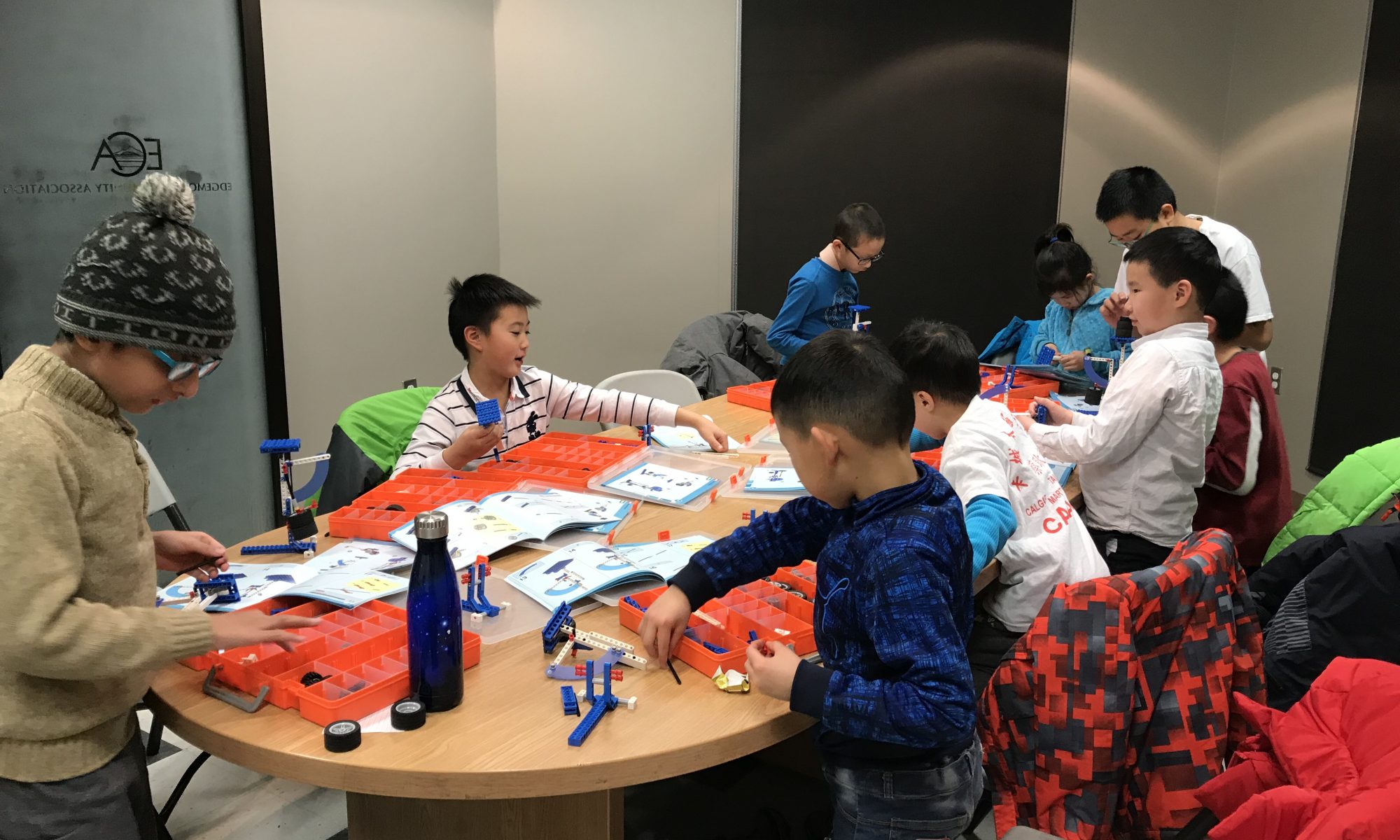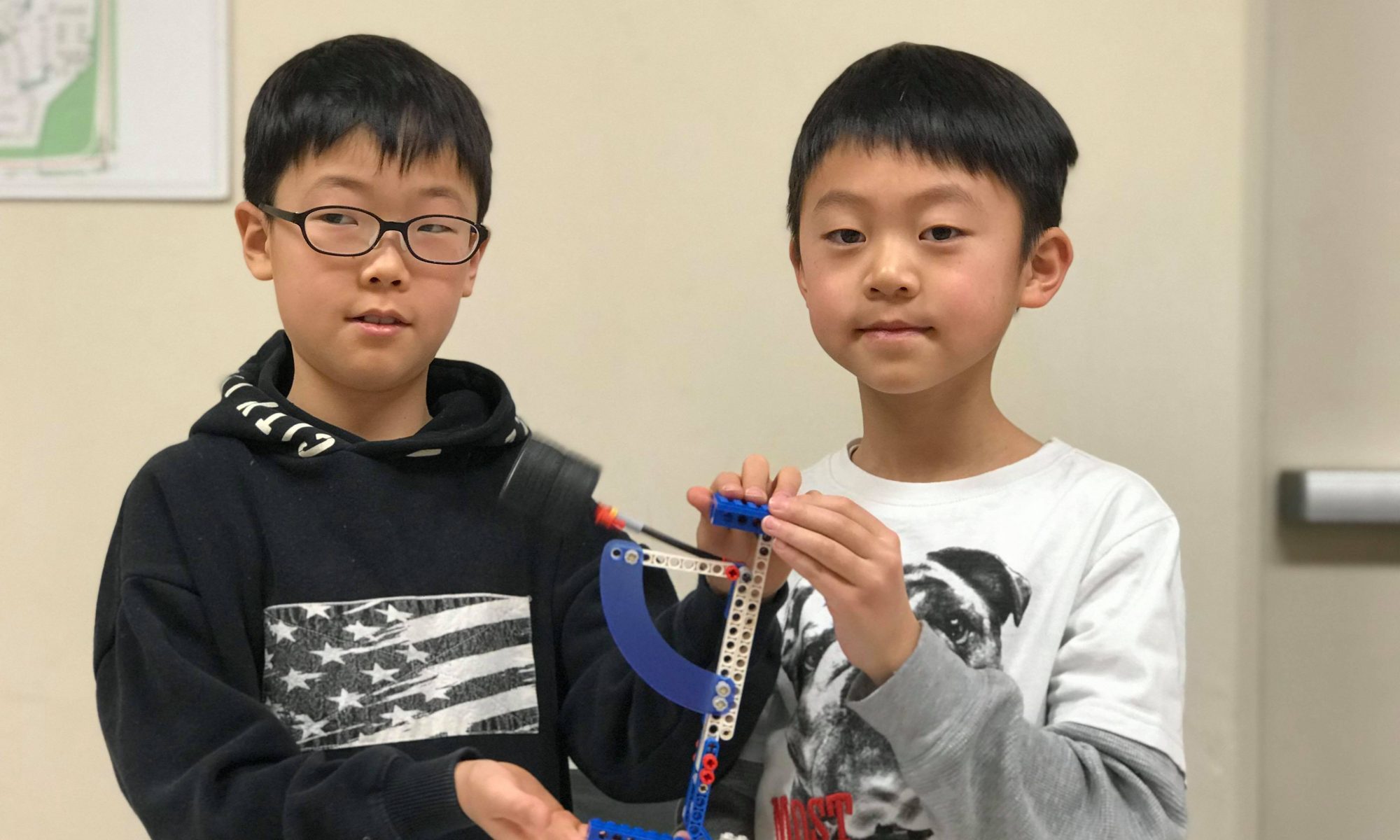The topic of today is the Walker. The students built a big cricket (a legged robot) to learn the basic knowledge of mechanical balance and friction. The legged robot is comprised of four legs with a wheel at each end, it can walk power by the motor. The motor axis motions are transferred by a worm gear, and then to the legs. The STEM information behind this section is the basic mechanical mechanism and concepts including the worm gear, friction and balance. All students finished the model and conducted tests by changing the legs’ length to compare the walking speed and balance. They competed with each other and had a lot of fun.
PBP Phase 2: Class 2: Windmill
I apologise for the late Classminutes as there were some technical difficulties on my end.
Last class the students built a Windmill in order to learn the principles of wind energy and the effect of surface area on the power output. The students were able to finish all the models on time, some did need help however, and help cleaning up was much appreciated. Avery is very adept at group work however some groups are a bit difficult to make work. Yuan appears to be very good with the kits and demonstrates an good understanding of the material. The students seemed to like the Windmill alot to the point where the fan providing the wind was overcrowded.
On friday the 26th we will be building the Walker.
Apologies for the late response.
Il Ho Cho
PBP Phase 1: Class 2: Beam Balance
I apologise for the late Classminutes as there were some technical difficulties on my end.
Last class the students built a beam balance in order to measure and compare various loads. The students were able to finish all the models on time and help cleaning up was much appreciated. Lukas and Ryan are both fast builders and Selina has an eye for precision. The students seemed to like the balance alot and they found it fun to put various objects on the balance for their own experimentation.
On friday the 26th we will be building the Power Hammer.
Apologies for the late response.
Il Ho Cho
Communication ECA Phase I 20180124 The Hammer
The hammer turned out to be a fun project. Although this class was more difficult than the previous classes, everyone was able to finish their work and fully understand what they were working on. The kids also worked on their class assignments and did the experiments at the end of the class. We really do understand that the classes are extremely fun and entertaining, but we ask the children to make sure their work is done before 8 o’clock so they still have enough time for putting their pieces in their boxes before the class is finished. Next week the kids will be working on The Sweeper which is another interesting project.
Communication ECA Phase III Class 2: Wind Turbine 20180117
The theme of today is the wind turbine. The wind turbine model transferred the wind energy generated by a fan to electrical energy stored in the power meter. The experiment is a very good mimic to the real wind turbines used in real world. The students finished the model building part quickly, and then they all conducted and finished the experiment. During which I explained the STEM information, which is the power equals to voltage multiplies current. All students finished the experiments and filled the lab sheets. They love the challenging project.
Communication ECA Phase I 20180117 The Balance
The balance was an interesting project which gave the kids a chance to make an applicable tool and turn the classroom into a laboratory. They figured out the framework pretty quickly and at the end of the class were given an experiment. The experiment not only meant more playtime, but also meant practicing more of the concept they were experimenting with (concepts such as weight, mathematical equality, and simple Newtonian mechanics). Although the second class was a bit more challenging than the first, I was really happy to see that all of the kids finished their works in time. I will look forward to our class next week where we will be working with the Hammer.
Communication ECA Phase II Class 2: Windmill 20170117
The topic of today is the windmill. The students built a windmill to learn the energy conversions between wild energy and rotational energy by means of blades. Windmills were used to mill grain, pump water in the history, but the majority of modern windmills take the form of wind turbines used to generate electricity, or wind pumps used to pump water. In the class, we used a weight as water to mimic the pumping water process. The STEM information behind this section is the energy transformation as well as force and motion concepts. All students finished the model and conducted tests with a different level, they enjoyed the class.
Communication ECA Phase III Class 1: Hand Generator 20180110
Phase III is the highest level of class in Play2Learn Education Lego Challenge Program. In the next 8 weeks, different energy form transformations will be discussed including energy experiments between kinematic energy and potential energy, electrical energy and kinematic energy, heat (light) energy and electrical energy.
The first class was to build a hand generator that transfers kinematic energy to electrical energy. The kinematic energy is generated by the students’ hand. The generated energy was stored in the power meter. In the first class, the basic skills to use the power meter and motors were explained. The section was intense because the students need to learn the principle model knowledge and finish the hand generator model building. However, after the first class, they gained a good understanding of the power meter and motors which laid a solid ground for the following classes.
Communication ECA Phase II Class 1: Letter Balance 20180110
Phase II is the middle-level class of Play2Learn Education Lego Challenge Program. In the next 8 weeks, the students will have good opportunities to learn and practice the basic mechanical mechanisms including lever, wheel and axle, pulley, wedge and screw.
The topic of today is the lever study using the letter balance model built during the class. The students first built a letter balance model, then they conducted the experiments to weigh various amount water to feel the level balance rule. The STEM information behind this section is the level balance rules. The level model composing of a four-bar mechanical mechanism that will be discussed more in the following classes. All the students finished the model building part and did the experiment with different level. They enjoyed this section. More principle modules will be delivered to the student can learn some basic mechanical rules in Phase II.
PBP Phase 2: Class 1: Letter Balance
Today we built the Letter Balance after splitting into groups of two. All the students managed to finish quickly and even got their homework done in class. We learned about estimating weight and force due to gravity, while there was not enough time to explain torque the children seemed to enjoy themselves.
Next week’s model is the Windmill
The children were all we behaved and worked well with each other and I hope that they will continue to do so.












